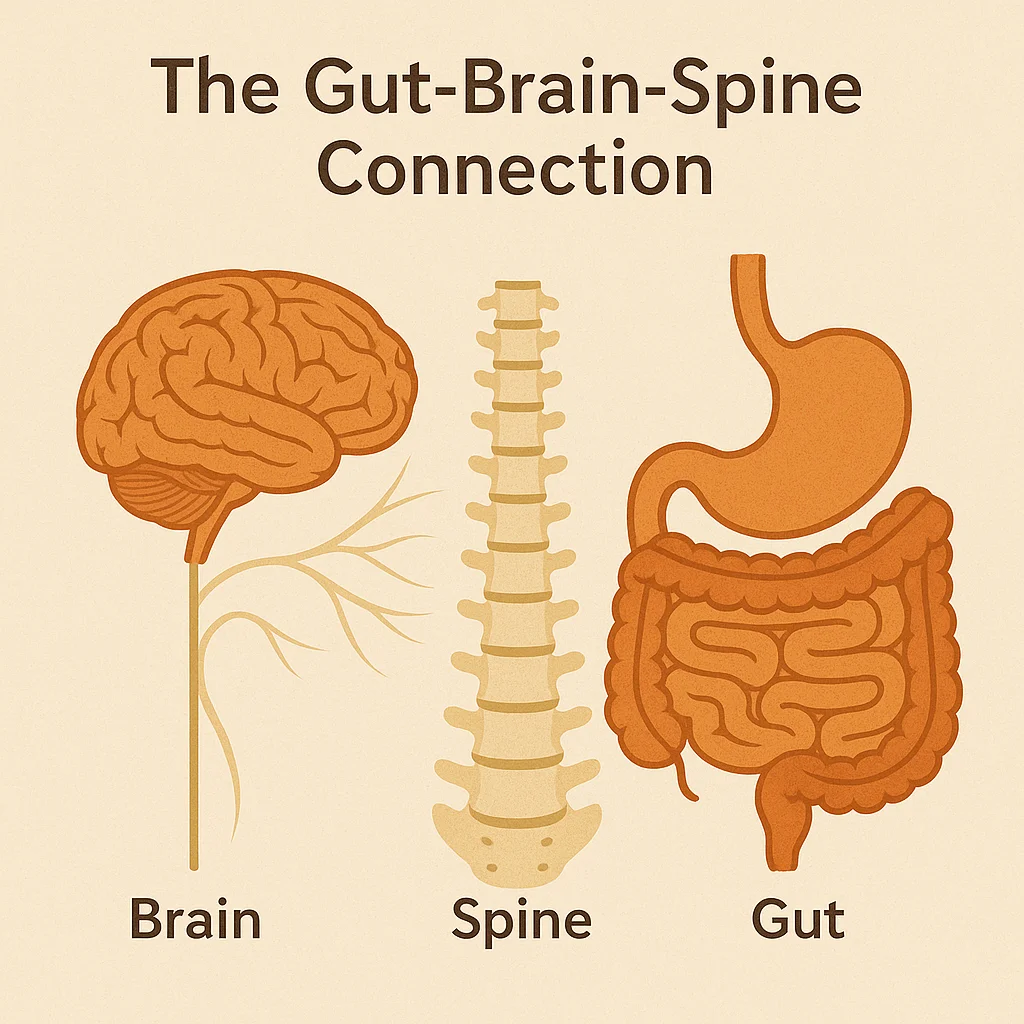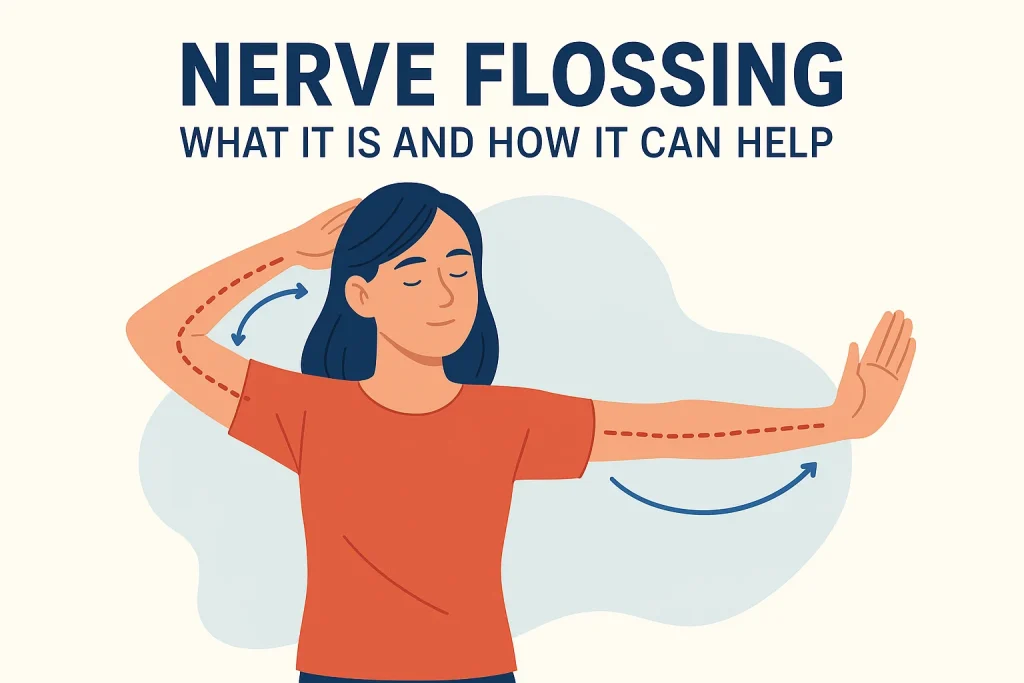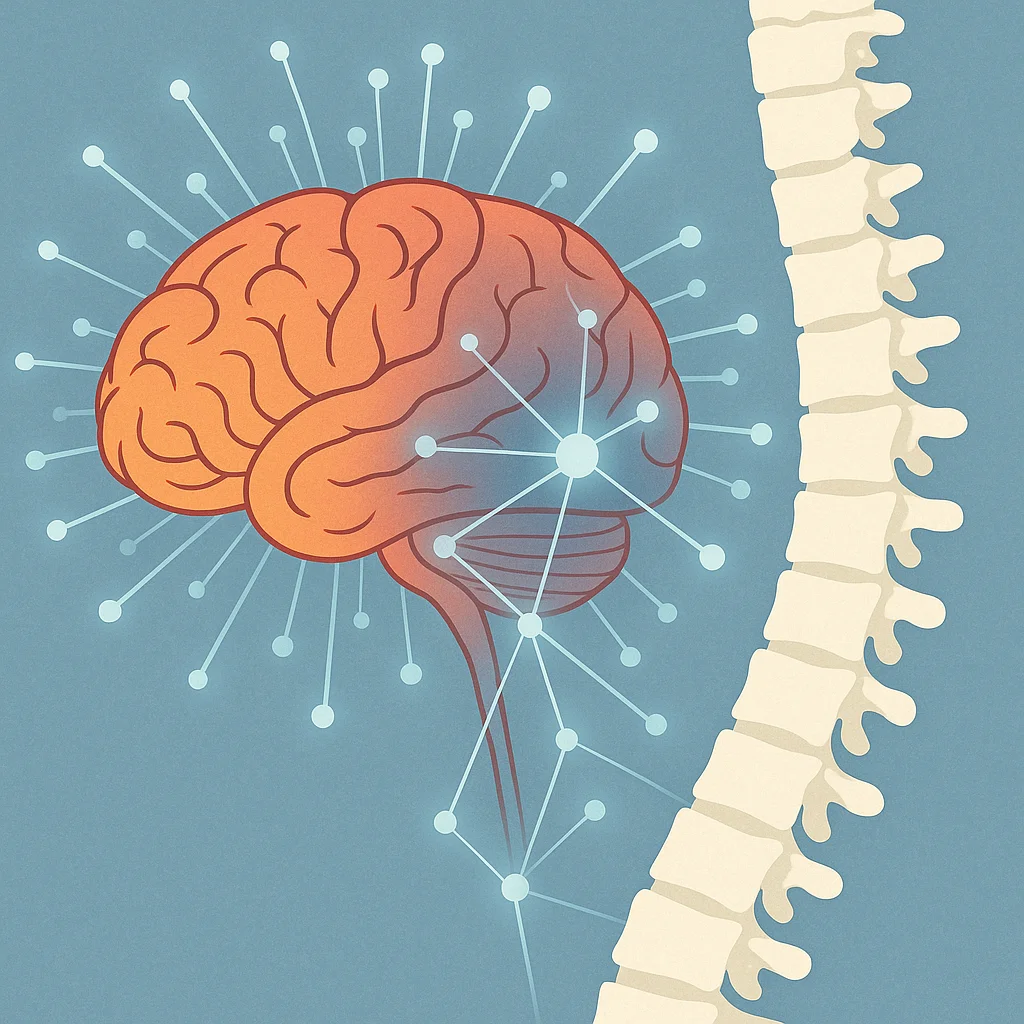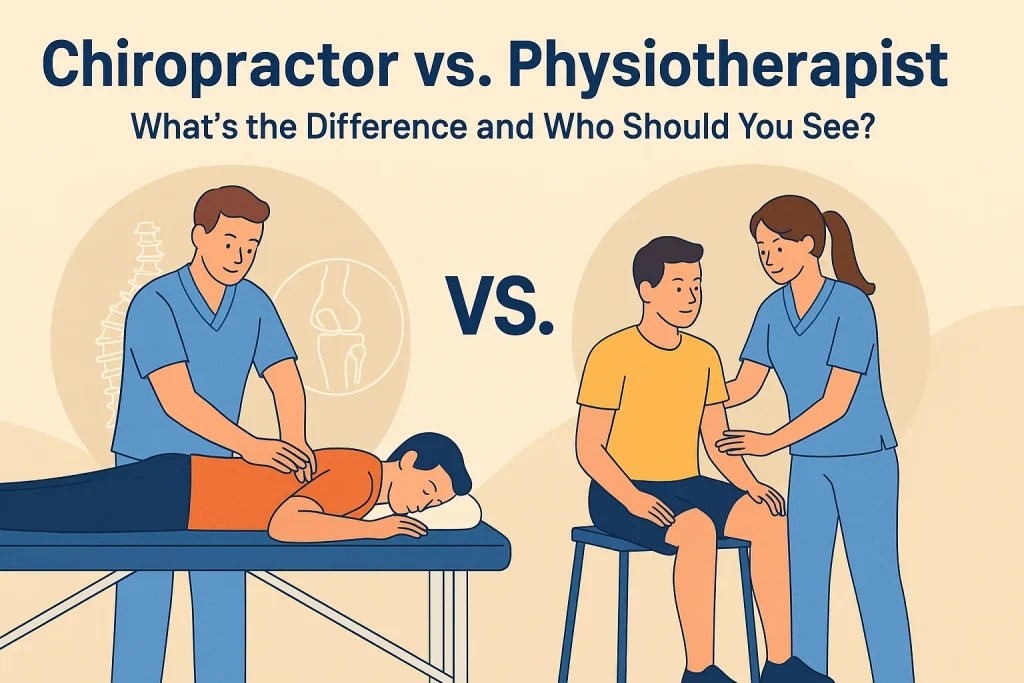The Gut-Brain-Spine Connection: How Your Digestive Health Influences Your Nervous System

At Dr. Erin Madonia Chiropractic, we believe in treating the whole body, not just the symptoms. One of the most fascinating discoveries in modern health science is the intricate relationship between our gut, brain, and spine—a connection that profoundly impacts our overall wellbeing. Understanding this relationship can revolutionize how we approach spinal health, nervous system function, and quality of life. Understanding the Gut-Brain Axis The gut-brain axis is a bidirectional communication network that links your digestive system with your central nervous system. This isn’t just a metaphorical connection—it’s a physical and chemical highway where information flows constantly in both directions. Your gut contains approximately 500 million neurons, forming what scientists call the enteric nervous system, often referred to as your “second brain.” This extensive neural network communicates directly with your brain through the vagus nerve, one of the longest and most important nerves in your body that runs from your brainstem down through your spine and into your abdomen. What makes this connection even more remarkable is the gut microbiome—the trillions of bacteria, fungi, and other microorganisms living in your digestive tract. These microscopic inhabitants produce neurotransmitters, including serotonin, dopamine, and GABA, the same chemicals your brain uses to regulate mood, sleep, and stress responses. In fact, approximately 90% of your body’s serotonin is produced in the gut, not the brain. The Gut Microbiome’s Role in Spinal and Nervous System Health As a chiropractor, I’ve witnessed firsthand how digestive health influences spinal function and overall nervous system performance. The connection might not be immediately obvious, but it’s profound and multi-layered. When your gut microbiome is balanced and healthy, it produces anti-inflammatory compounds that help reduce systemic inflammation throughout your body, including the tissues surrounding your spine. Chronic inflammation is a significant contributor to spinal discomfort, muscle tension, and impaired nervous system function. An unhealthy gut can trigger inflammatory responses that manifest as increased pain sensitivity, muscle stiffness, and reduced spinal mobility. The vagus nerve, which we mentioned earlier, is particularly important in chiropractic care. This nerve runs directly alongside the spine and plays a crucial role in regulating inflammation, stress responses, and the parasympathetic nervous system—your body’s “rest and digest” mode. When gut health is compromised, vagal nerve function can be impaired, leading to increased muscle tension, particularly in the neck and upper back, and reduced capacity for your body to heal and recover from spinal stress. Additionally, an imbalanced gut microbiome can affect nutrient absorption, particularly B vitamins and magnesium, which are essential for proper nerve function and muscle relaxation. Deficiencies in these nutrients can contribute to increased muscle tension, nerve sensitivity, and a reduced ability to maintain proper spinal alignment. How Digestive Health Affects Your Posture and Pain Perception The gut-brain-spine connection also influences how we experience and respond to pain. When your digestive system is under stress—whether from poor diet, inflammation, or microbial imbalance—it sends distress signals through the vagus nerve to your brain. This can heighten your overall pain sensitivity, meaning that spinal issues you might normally tolerate become more uncomfortable and debilitating. Poor gut health can also affect your posture in surprising ways. Digestive discomfort, bloating, and abdominal tension can cause you to unconsciously alter your posture, creating compensatory patterns that strain your spine, particularly in the lower back and thoracic region. Over time, these postural compensations can lead to chronic misalignments and biomechanical dysfunction. The Three Pillars of Gut-Brain-Spine Balance Maintaining a healthy gut-brain-spine connection doesn’t require complicated interventions. Instead, focusing on three fundamental pillars can create remarkable improvements in both digestive and spinal health. 1. Hydration: The Foundation of Function Water is essential for every system in your body, and both your gut and spine depend heavily on adequate hydration. Your spinal discs are composed of approximately 80% water, and they rely on proper hydration to maintain their height, cushioning ability, and nutrient exchange. When you’re dehydrated, these discs can compress, leading to reduced spinal flexibility, increased susceptibility to injury, and heightened pain responses. For your digestive system, water is equally critical. It helps break down food, facilitates nutrient absorption, and keeps things moving smoothly through your intestines. Adequate hydration also supports the mucous lining of your gut, which protects your intestinal wall and houses beneficial bacteria. Aim for at least eight to ten glasses of water daily, more if you’re physically active or live in a warm climate. A simple way to check your hydration status is to observe your urine color—it should be pale yellow. Dark urine is a sign you need to increase your water intake. 2. Fibre: Fuel for Your Microbiome Dietary fibre is perhaps the most important nutrient for maintaining a healthy gut microbiome. Fibre acts as a prebiotic, meaning it feeds the beneficial bacteria in your gut, helping them thrive and outnumber potentially harmful organisms. There are two types of fibre, and both are important. Soluble fibre, found in foods like oats, beans, apples, and carrots, dissolves in water and helps regulate blood sugar and cholesterol while feeding beneficial gut bacteria. Insoluble fibre, found in whole grains, nuts, and vegetables, adds bulk to your stool and keeps your digestive system moving efficiently. When your gut bacteria are well-fed with fibre, they produce short-chain fatty acids, particularly butyrate, which has powerful anti-inflammatory properties. These compounds help reduce inflammation not just in your gut, but throughout your entire body, including the tissues around your spine. Most people need 25-35 grams of fibre daily, but it’s important to increase your intake gradually to avoid digestive discomfort. Focus on whole foods like vegetables, fruits, legumes, whole grains, nuts, and seeds. The diversity of fibre sources is just as important as the quantity—different types of fibre feed different bacterial species, so eating a varied diet promotes a more diverse and resilient microbiome. 3. Stress Reduction: Calming the Nervous System Chronic stress is one of the most damaging factors for both gut and spinal health. When you’re stressed, your body activates the sympathetic nervous system—the “fight or flight” response. This diverts resources
Nerve Flossing: What It Is and How It Can Help

If you’ve ever felt tingling, numbness, or shooting pain down your arm or leg, you may have experienced nerve irritation. While joints and muscles get most of the attention when it comes to mobility, your nervous system also needs to move freely. That’s where a technique called nerve flossing (or nerve gliding) comes in Important Safety Note While nerve flossing can be beneficial, it must be done correctly. Incorrect technique or overuse may worsen symptoms. This blog is for educational purposes only and is not medical advice. Always consult a licensed healthcare practitioner-such as a chiropractor, physiotherapist, or medical doctor-before starting any new exercises, especially if you have nerve pain or numbness. What Is Nerve Flossing? Nerve flossing is a gentle exercise technique designed to improve the mobility of irritated or compressed nerves. Just like a muscle can feel tight, nerves can also become restricted due to surrounding tissues, inflammation, or poor posture. Nerve flossing involves specific, controlled movements that “glide” the nerve through its pathway, helping reduce tension and restore natural mobility. Think of it as giving your nerves more room to move-like sliding a cord back and forth through a protective sleeve Why Does It Work? Healthy nerves should move smoothly as your body bends, stretches, and twists. When that mobility is compromised, you may experience discomfort such as: – Tingling or “pins and needles” sensations – Numbness – Sharp or radiating pain – Weakness in certain muscle groups By gently mobilizing the nerve with flossing movements, you may help: – Improve blood flow to the nerve – Reduce sensitivity and irritation – Relieve pressure from surrounding tissues – Support better function in the muscles the nerve supplies When Is Nerve Flossing Recommended? Nerve flossing may be suggested as part of a broader treatment plan for conditions like: Sciatica Carpal Tunnel Syndrome Cubital Tunnel Syndrome Lumbar or Cervical Disc Herniations It’s important to note that nerve flossing is not a stand-alone fix-it often works best when combined with chiropractic adjustments, soft tissue therapy, strengthening, and postural changes The Chiropractic Connection Chiropractors often recommend nerve flossing as part of a comprehensive care plan. By restoring proper spinal alignment and relieving joint or soft tissue restrictions, chiropractic adjustments can complement nerve mobility exercises-helping you move more freely and comfortably. This blog is for educational purposes only and is not medical advice. Always consult a licensed healthcare practitioner-such as a chiropractor, physiotherapist, or medical doctor-before starting any new exercises, especially if you have nerve pain or numbness. For more information, you can book a free consultation or schedule an appointment with us by clicking the buttons down below 👇 Book a Free Consultation Book an Appointment
Ergonomic Success: 5 Office Tips to Keep Your Spine Happy

More than 80% of people will experience low back pain at some point in their lifetime—and if you’re sitting for hours with poor posture, that risk only increases Repetitive motions like typing, mousing, and phone use can pile on physical strain alongside mental stress. But incorporating effective ergonomic habits into your workday can make a world of difference. Here are five essential tips to protect your back and enhance your comfort. 1. Sit Tall—Honor Your Spine’s Natural Curves Maintaining proper spinal alignment reduces the workload on your muscles and ligaments. Align your ears, shoulders, and hips, sit with your buttocks firmly at the back of the chair, and keep your chest elevated for optimal posture. 2. Adjust Your Chair—Make It Work for You Support your shoulders and lower back using the chair’s backrest—or add a lumbar pillow or rolled towel if needed. Key adjustments include: Seat height: Should be just below your kneecaps when standing. Hip-to-floor angle: Ensure your thighs are parallel to the floor; feet flat, knees level with or slightly below your hips. Armrests: Adjust so your elbows bend at about 90°, or remove them if they force tension. Take mini-breaks every 30–45 minutes to stretch or shift position—it’s as critical as the setup itself. 3. Position Your Monitor—Protect Your Neck Ensure your screen is directly in front of you, with the top line of text —not just the top of the monitor—set at eye level. If your monitor lacks adjustability, elevate it using books or a riser. Regularly look away from the screen and mix up tasks to ease eye strain. 4. Optimize Keyboard & Mouse Placement Keep your wrists straight, arms relaxed, and forearms parallel to the floor. Elevate your keyboard if necessary to maintain shoulder relaxation. If using a laptop often, consider an external keyboard—and position your mouse close by to avoid unnecessary reaching. 5. Move Often—Avoid “Perfection” In Posture Switching positions regularly is more beneficial than holding an “ideal” pose for hours. Change posture every 30–40 minutes, get up, stretch, or take a quick walk. Talking on the phone? Use a headset—or at least switch hands or support the phone to avoid neck strain. Why It Matters—From a Chiropractic Perspective A well-structured ergonomic setup isn’t just about comfort—it supports spinal health. By promoting proper alignment, you reduce mechanical stress and the risk of alignment issues that can lead to pain or dysfunction. Ready for Chiropractic Support? If you’ve tried these ergonomic strategies and still experience discomfort, a chiropractor can guide you forward—offering personalized adjustments, ergonomic assessments, and tailored exercises to help you stay pain-free and productive. For more information, you can book a free consultation or schedule an appointment with us by clicking the buttons down below 👇 Book a Free Consultation Book an Appointment
Unlocking the Connection: How Chiropractic Adjustments Influence Your Nervous and Motor Systems

When most people think about a chiropractic adjustment, they imagine a quick “crack” to relieve back or neck pain. While adjustments can relieve pain and improve mobility, research is showing that their effects go far deeper—reaching into how your brain and nervous system communicate with the rest of your body. Let’s break it down: The Nervous System: Your Body’s Command Center Your nervous system includes your brain, spinal cord, and all the nerves branching out to your limbs and organs. It controls everything from your movements to how you feel pain, balance, and even how well your muscles fire during activity. When your spine isn’t moving properly—or certain joints are restricted—it can interfere with the signals traveling between your brain and body. This is where chiropractic care comes in. What Does a Chiropractic Adjustment Do? A chiropractic adjustment helps restore proper movement in the spine or joints. But beyond simply improving range of motion, it also sends powerful signals to your nervous system. Think of it as “rebooting” certain pathways that may not be functioning optimally. Adjustments and the Brain-Body Connection Recent studies using tools like EEG (electroencephalography) and EMG (electromyography) have shown that spinal adjustments can lead to changes in how the brain processes sensory and motor information. Here’s what that means: Improved Brain Processing: One study found that after a spinal adjustment, the brain becomes better at integrating and responding to sensory input (like balance, movement, and coordination). This may explain why many patients report feeling more “connected” or “grounded” after treatment. Enhanced Muscle Control: Another study found that after just one spinal adjustment, there was increased muscle activation in the legs. This suggests adjustments may help your body recruit muscles more efficiently, which can benefit performance, stability, and even reduce injury risk. Refined Motor Planning: Your brain doesn’t just react—it also plans how your body will move. Chiropractic adjustments appear to influence this planning stage, helping fine-tune motor control before a movement even happens. So, Why Does This Matter? If you’ve ever thought of chiropractic care as just about pain relief or posture, think again. The adjustment is not just mechanical—it’s neurological. Every time your chiropractor adjusts your spine, they may be helping your brain process movement, balance, and coordination more effectively. These subtle changes in the nervous system could be why so many people report feeling clearer, more mobile, and more balanced after care. A Ripple Effect Throughout the Body Think of your nervous system like a Wi-Fi network. If your spine isn’t moving well, it’s like having a poor signal. A chiropractic adjustment can boost that signal—not just to relieve pain, but to enhance the entire way your body communicates and moves. In short, chiropractic care isn’t only about treating symptoms. It’s about optimizing how your brain and body work together. For more information, you can book a free consultation or schedule an appointment with us by clicking the buttons down below 👇 Book a Free Consultation Book an Appointment References: Haavik H, Niazi IK, Holt K, et al. (2021). The Impact of Spinal Manipulation on Cortical Drive to Upper and Lower Limb Muscles. Brain Sciences, 11(1), 12. https://pubmed.ncbi.nlm.nih.gov/33466707/ Haavik H, Kumari N, Holt K, et al. (2021). The Effects of a Single Session of Spinal Manipulation on Strength and Cortical Drive in Athletes. Brain Sciences, 11(6), 773. https://pubmed.ncbi.nlm.nih.gov/34164712/ Haavik H, Murphy B. (2012). Translating basic science into practice: what are the potential effects of spinal manipulation on the brain? Chiropractic & Manual Therapies, 20, 19. https://pubmed.ncbi.nlm.nih.gov/22483612/
How Chiropractic Care Can Help Relieve Sciatica

If you’ve ever experienced sciatica, you know how disruptive it can be. That sharp, shooting pain that radiates from your lower back down your leg can interfere with everything from sitting comfortably to enjoying your daily activities. . The good news? Chiropractic care offers a safe, non-invasive way to help manage and relieve sciatica pain. What Is Sciatica? Sciatica refers to irritation or compression of the sciatic nerve—the largest nerve in your body. Symptoms include lower back pain, numbness, tingling, or weakness that travels into the buttock and leg. It usually affects one side and may be triggered by a herniated disc, spinal misalignment, muscle tension (especially in the piriformis), or narrowing of the spinal canal (spinal stenosis). How Can Chiropractic Help? Chiropractors are trained to assess and treat the musculoskeletal system, including conditions like sciatica. After a thorough assessment, a chiropractor can develop a personalized care plan to manage symptoms and prevent then from returning. Depending on the cause, there are various ways a chiropractor can treat and manage sciatic-type symptoms: Spinal Adjustments:Gentle, controlled spinal manipulations help improve alignment, reduce pressure on the sciatic nerve, and restore proper joint movement. This can alleviate pain and improve mobility. Soft Tissue Therapy:Techniques like myofascial release, trigger point therapy, or cupping can target tight muscles or fascia that may be contributing to nerve irritation, especially in the gluteal region. Acupuncture and Modalities:Some chiropractors use adjunct therapies such as acupuncture or therapeutic laser therapy to reduce inflammation, promote healing, and improve circulation in affected areas. Movement & Rehabilitation:Chiropractors often prescribe specific exercises to stretch tight muscles, strengthen weak muscles and/or take pressure off an aggravated disc – which can help to reduce pain and the risk of future flare-ups. Education & Ergonomics:Identifying and correcting aggravating postures or activities —like prolonged sitting or poor lifting technique—can make a big difference in recovery and long-term prevention. When to Seek Help If your sciatic pain persists for more than a few days, worsens with activity, or is accompanied by weakness or numbness, it’s a good idea to seek professional care. Chiropractic can be a highly effective conservative option, and in some cases, may prevent the need for medication or surgery. The Bottom Line Chiropractic care offers a holistic and hands-on approach to managing sciatica pain. Through spinal adjustments, soft tissue therapy, movement education, and targeted rehab, chiropractors aim not just to relieve your current pain—but to help you move better and feel better for the long term. For more information, you can book a free consultation or schedule an appointment with us by clicking the buttons down below 👇 Book a Free Consultation Book an Appointment
Chiropractic Care During Pregnancy: Enhancing Comfort and Supporting a Healthy Journey

Pregnancy is a transformative time, bringing many physical changes. As the body adapts to support a growing baby, many expectant mothers experience discomforts such as back pain, pelvic pressure, and joint stiffness. Chiropractic care offers a non-invasive, drug-free approach to alleviate these discomforts and promote overall well-being during pregnancy. Benefits of Prenatal Chiropractic Care Alleviation of Back and Pelvic Pain – As pregnancy progresses, hormonal changes and a shifting center of gravity can lead to spinal strain and misalignments, resulting in lower back and pelvic pain. Chiropractic adjustments can help balance the spine and pelvis, reducing discomfort and improving mobility. Optimal Fetal Positioning – Proper pelvic alignment is crucial for the baby’s positioning in the womb. Chiropractic care can help maintain pelvic balance, potentially reducing the risk of a breeched presentation and facilitating a smoother delivery. Enhanced Nervous System Function – The nervous system plays a vital role in overall health. Chiropractic care supports nervous system function by addressing spinal misalignments, which can improve sleep quality, digestion, and energy levels during pregnancy. Safety Considerations Chiropractic care is generally considered safe during pregnancy when performed by a practitioner trained in prenatal techniques. These professionals use specialized methods to accommodate the anatomical changes of pregnancy, ensuring comfort and safety for both mother and baby. Conclusion Incorporating chiropractic care into prenatal health routines can offer significant benefits, from pain relief to improved overall wellness. As always, it’s essential to consult with your healthcare provider before beginning any new treatment during pregnancy. With the right support, chiropractic care can be a valuable component of a healthy, comfortable pregnancy journey. References Links: https://chiropractic.ca/chiropractic-care-for-pregnant-patients/ https://www.henryford.com/blog/2020/11/how-chiropractic-care-can-promote-healthy-pregnancy https://www.healthline.com/health/pregnancy/chiropractor-while-pregnant
Stay Active and Injury-Free: 8 Summer Fitness Tips for a Healthy Back

Summer is the perfect time to embrace outdoor activities—whether it’s gardening, golfing, running, or simply enjoying nature. These pursuits not only boost your mood but also enhance mobility, strengthen bones, and alleviate stress. However, it’s essential to approach them mindfully to prevent back injuries and ensure long-term wellness. Here are eight expert-backed tips to keep your back healthy and your body thriving this summer: 1. Start with a Gentle Warm-Up Before diving into any activity, take a few minutes to prepare your body. A brisk 5-minute walk followed by dynamic stretches can increase blood flow and loosen muscles, reducing the risk of injury. For instance, if you’re heading out for a run, incorporate leg swings and hip circles to activate key muscle groups. 2. Master Proper Techniques Using the correct form is crucial to prevent injuries. Gardeners should opt for kneeling instead of bending when planting. Golfers might benefit from professional lessons to refine their swing and avoid repetitive strain. Remember, quality trumps quantity—prioritize proper technique over extended durations. 3. Enhance Mobility and Flexibility Regular stretching and mobility exercises can significantly improve your range of motion. Incorporate routines that target major muscle groups, such as yoga or Pilates, to maintain flexibility. For example, runners should focus on calf and hamstring stretches to support optimal performance. 4. Stay Hydrated Hydration is key, especially during warmer months. Drink water before, during, and after physical activities. Dehydration can lead to muscle cramps, decreased coordination, and increased risk of injury. Consider carrying a reusable water bottle to ensure consistent intake. 5. Pace Yourself Avoid the temptation to overexert, especially if you’re returning to an activity after a hiatus. Break tasks into manageable segments—for instance, tackle gardening in 30-minute intervals with short breaks in between. This approach helps prevent fatigue and reduces strain on your back. 6. Cool Down Properly After completing your activity, dedicate time to cool down. Engage in gentle stretches and deep breathing exercises to help your body transition to a resting state. This practice aids in muscle recovery and reduces post-activity stiffness. 7. Dress Appropriately Wearing the right gear can make a significant difference. Choose supportive footwear that aligns with your activity—running shoes for jogging, sturdy boots for hiking, etc. Additionally, opt for breathable, moisture-wicking clothing to stay comfortable and prevent overheating. 8. Listen to Your Body Pay attention to any signs of discomfort or fatigue. Persistent pain is a signal to rest and, if necessary, consult a healthcare professional. Chiropractors can assess musculoskeletal issues and provide guidance on safe activity modifications. Bonus Tip: Incorporate Strength Training Building core strength supports spinal health and enhances overall stability. Integrate exercises like planks, bridges, and resistance band workouts into your routine to fortify your back and prevent injuries. Final Thoughts Embracing an active lifestyle during summer is both enjoyable and beneficial for your health. By following these tips, you can maximize the season’s offerings while safeguarding your body. Remember, consistency and mindfulness are key—prioritize proper techniques, stay hydrated, and listen to your body’s cues. For personalized advice and support, consider consulting with a chiropractor. They can provide tailored recommendations to help you stay active and pain-free throughout the summer. Stay safe and enjoy your summer adventures! Retrieved from https://chiropractic.on.ca/
Chiropractor vs. Physiotherapist: What’s the Difference and Who Should You See?

If you’re experiencing pain, recovering from an injury, or looking to optimize your movement and overall health, you may have considered seeing a chiropractor or a physiotherapist. Both professionals play crucial roles in the healthcare system and can help with a wide range of musculoskeletal issues. But what exactly is the difference between the two? Let’s break it down. Education & Training One key difference between chiropractors and physiotherapists is the amount of education required to enter their respective fields. Chiropractors complete a four-year Doctor of Chiropractic (DC) degree after completing an undergraduate program. This extensive training includes in-depth study of the nervous system, human anatomy, spinal health, biomechanics, and hands-on clinical experience. Physiotherapists typically complete a two-year Master’s degree in physiotherapy after their undergraduate studies. Their education focuses on movement science, rehabilitation, and physical function. Both professions require rigorous training and a deep understanding of the human body, ensuring they are well-equipped to provide expert care. Approach to Treatment While both chiropractors and physiotherapists treat musculoskeletal issues, they often have different approaches: Chiropractors focus on the relationship between the spine and the nervous system. They use spinal adjustments, manual therapy, and other techniques to restore alignment, relieve nerve interference, and improve overall function. Chiropractic care is often associated with reducing pain, improving mobility, and enhancing nervous system function. Physiotherapists focus on rehabilitation through exercise, manual therapy, and education. They design personalized treatment plans to restore movement and strength, often incorporating techniques such as soft tissue therapy, joint mobilizations, and rehabilitation exercises. What Conditions Do They Treat? Both chiropractors and physiotherapists treat a variety of conditions, including: Back and neck pain Sports injuries Postural issues Joint pain and stiffness Repetitive strain injuries Rehabilitation after surgery or injury Which Practitioner is Right for You? There is no one-size-fits-all answer—it depends on your specific needs and preferences. If you are looking for spinal adjustments, nervous system-focused care, or relief from conditions like sciatica or headaches, a chiropractor may be the right choice. If you need rehabilitation exercises, movement retraining, or post-surgical recovery support, a physiotherapist might be best suited for you. The good news? You don’t have to choose just one! Many people benefit from a combined approach, working with both chiropractors and physiotherapists to achieve optimal health and function. Final Thoughts Both chiropractors and physiotherapists are amazing practitioners who bring unique skills to the table. Whether you choose chiropractic care, physiotherapy, or a combination of both, the ultimate goal is to help you move better, feel better, and live a healthier life. If you’re unsure which option is right for you, book a free consultation or book an appointment, and let’s find the best approach for your needs! Book a Free Consultation Book an Appointment
Stronger Every Day: The Science-Backed Benefits of Strength Training

Incorporating strength training into your routine isn’t just about building muscle—it’s a game-changer for your overall health and longevity. Often overlooked in favor of cardio, resistance training plays a crucial role in maintaining a strong, resilient body while offering a host of mental and metabolic benefits. Whether you’re lifting weights, using resistance bands, or engaging in body-weight exercises, strength training helps improve bone density, boost metabolism, support joint health, and even enhance mood. Backed by research, it’s one of the most effective ways to maintain mobility, prevent chronic disease, and improve your quality of life at any age. Let’s explore the science behind strength training and why it deserves a permanent place in your wellness routine. 1. Enhances Musculoskeletal Health Engaging in strength training promotes the health of your muscles and bones. It helps maintain bone density, reducing the risk of osteoporosis, and combats age-related muscle loss, thereby preserving functional abilities. 2. Boosts Metabolic Rate Regular resistance training can increase lean muscle mass, which in turn elevates your resting metabolic rate. This means you’ll burn more calories even when not exercising, aiding in weight management. 3. Improves Mental Health Strength training has been linked to better mental health outcomes. Studies have shown it can reduce symptoms of anxiety and depression, enhance mood, and improve overall psychological well-being. 4. Enhances Quality of Life for Older Adults For individuals over 50, incorporating strength training into their routine is crucial. It helps maintain muscle mass, supports bone health, and improves balance, reducing the risk of falls and enhancing overall quality of life. 5. Supports Long-Term Health and Longevity Regular physical activity, including strength training, is associated with a longer, healthier life. It reduces the risk of chronic diseases, improves cardiovascular health, and supports overall bodily functions, contributing to increased life expectancy. Getting Started with Strength Training If you’re new to strength training, consider the following tips: Start Slow: Begin with lighter weights or body-weight exercises to learn proper form. Seek Professional Guidance: Consult with a fitness professional to create a personalized program and ensure exercises are performed correctly. Consistency is Key: Aim for regular sessions, gradually increasing intensity as your strength improves. Incorporating strength training into your routine can lead to significant improvements in health and well-being. Whether you’re a beginner or looking to refine your routine, having the right guidance can make all the difference. If you’re unsure where to start or want personalized recommendations for safe and effective exercises, schedule an appointment today! Let’s work together to build strength, improve mobility, and keep you feeling your best. Resources: https://pubmed.ncbi.nlm.nih.gov/32564299/ https://www.healthline.com/health/fitness/benefits-of-strength-training https://pubmed.ncbi.nlm.nih.gov/22777332/
Lift Smart, Stay Strong: Preventing Back Injuries with Proper Lifting Techniques

Whether you’re rearranging furniture, picking up groceries, working out in the gym, or lifting heavy equipment at work, using the right lifting techniques can be crucial for protecting your back. As a chiropractor, we see firsthand how improper lifting techniques contribute to back pain, muscle strains, and even long-term spinal issues. The good news? With the right approach, you can protect your body, reduce the risk of injury, and improve overall movement efficiency Safe Lifting Tips to Prevent Back Injury: Bend at your knees to lift with ease. Stand close to the load to maintain control and reduce strain. Position your feet shoulder-width apart for stability. Bend your knees and don’t arch your back to engage your leg muscles. Squat down and test the weight before attempting to lift. Ask for help if the object is too heavy or awkward to carry alone. Use your legs and arms, not your back or hips, to generate power for lifting. Move smoothly and avoid jerking motions that can strain muscles. Keep the load close to your body to maintain balance. Avoid twisting your spine while carrying the load. Instead, pivot with your feet. Lower the object carefully, bending your knees to control the descent. Incorporating these simple yet effective lifting techniques into your daily routine can make a significant difference in preventing back injuries. Being mindful of how you lift helps keep your spine strong and pain-free. If you’ve injured yourself while lifting, a chiropractor can help assess, diagnose, and treat the injury, getting you back to pain-free movement as quickly as possible Stay safe, lift smart, and protect your body for the long run! References: https://chiropractic.ca/lifting-tips-from-canadian-chiropractors/
